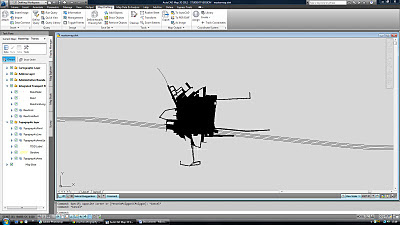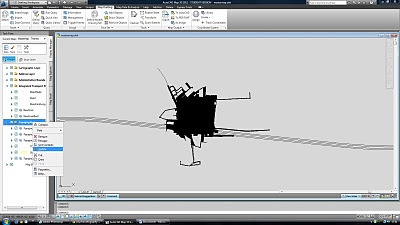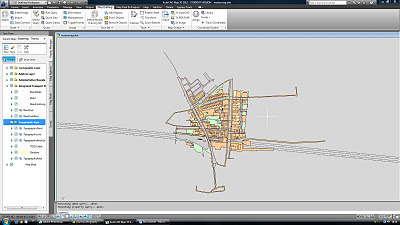[we]b-log
Last year each of us on the BA landscape architecture and BA garden design programmes were told to keep a blog of our studio activities. I already had been using this site (to post intermittently) prior to the course and thought I'd carry on here. The blog was a really useful way of maintaining contact with other students and extending the studio beyond the confines of the South Studio mezzanine, out of meat space and into the rest of the world.
Problem is, I have a problem. And that problem is that I oft feel the compulsion to write about things going on in my life. It's what I used to do when I kept a blog on myspace (one for sgla and one for youssef ifscapulet) at a very different stage. Thing is, the kind of idiot who feels the need to share the tedious minutiae of their lives on the internet is the kind of idiot I can do without. However, I guess I have to learn to accept that maybe I am that sort of person.
Anyway, where is this all going? Well, it occurred to me that for a blog that is ostensibly about landscape architecture, I don't spend much time talking about it. Even the title- psychocartography- is supposed to be some kind of reference to the unitary urbanist practice of psychogeography, an activity I almost always manage to squeeze onto my CV (mainly to see if I get asked about it in interview*) yet fail to talk about much here.
psychogeography
So what's psychogeography? I'm sure it means different things, depending on whether you're asking Guy Debord or Ian Sinclair or Will Self or Merlin Coverly. To me psychogeography is about urban exploration: a purpose[less/ful- delete as applicable] ramble across the city, with or without a map. It's a time to discover new places or spend a little longer in familiar areas, a time to think, a time to be alone with the urban environment.
When I was a kid, growing up in a sprawling seaside town at the end of the A13 corridor, I spent a lot of time seeking out obscure corners of Southend with my friends and doing the usual stuff prepubescent boys do: minor acts of vandalism, firing air guns at defenceless animals, gawping at pornography or otherwise causing a nuisance. These activities took place in abandoned buildings, overgrown parks, the sidings of railway lines or other pieces of neglected civil infrastructure. I never really grew out of it, and though the anti-social activity roster became more varied in my teenage years, I still liked to cycle to weird places and explore them. I suppose in many ways I was lucky to live in a town with so many dilapidated buildings- not to mention abandoned jetties and piers and an easily accessible countryside peppered with pill boxes and abandoned military gun emplacements.
When I came to London about ten years ago, I still hadn't lost the urge to explore. But I did lose a bit of bottle. When one is deemed a "fit and proper person" (the result of my status as a liquor licensee), it is prudent to think twice about crawling through gaps in fences to explore abandoned cement works. I replaced the desire to trespass with the joy of discovering hitherto unseen corners of the city on foot. Whilst these areas might appear unremarkable to those resident there, learning how the different fabrics of the city were crudely woven together was an important part of my education as a future urban designer. Furthermore, I found long walks through the town presented a great chance to clear my head and process recent events.
As I began to explain at the beginning of this now rambling post, it has been a weird week. I thought I'd broken my foot on Monday evening following a sequence of bizarre incidents culminating in a torn t-shirt, wounded pride and a very heavy amplifier(worth £400) falling on my right peg. I couldn't walk for a few days, but after receiving some elephant-strength opiates from a happy practitioner at the Homerton (and an x-ray allaying any fears of anything more significant than soft tissue damage) I was back on my feet by Friday. So: I missed the first week of the diploma course and also had abandoned my musical project. It was all a bit sad.
Fast forward twenty four hours and despite having eaten one of the finest dinners of 2011 AND having spent the night with a pretty girl I awoke with a terrible melancholy. Suffice to say, said pretty girl- my girlfriend- was unimpressed and some short, sharp exchanges led to my angry exit, apparently unappreciative of my right foot's miraculous recovery.
I went for a wander. It was a glorious day.
I drifted along the Parkland Walk, an abandoned railway line and nature reserve linking Finsbury Park to Highgate Wood. Because this urban greenway occupies an old viaduct, its passage is uninterrupted by roads, passing over them (and sometimes under them) and creating an illusory sense of separation from the city. Even though at times the backs of houses are visible, I feel transported to a faraway time and place. I used to run along here when I lived in Stroud Green, watching the seasons unfold as I pounded heavily up the old track, hoping one day to witness a muntjac leap from the undergrowth.
de beauvoir
Perhaps it would be interesting to describe every inch of my journey from Finsbury Park, up the Blackstock Road, round the tall Victorian villas of Highbury and into Clissold Park before hitting the Kingsland Road. But I can't be bothered. Suffice to say that eventually my tramping took me to Dalston, loud and grimy in the unfeasibly hot October sun. Thee was a lot of noise in my head and I wanted to get away, but it was Saturday and every park in London was full of people enjoying the glorious weather. So instead I drifted away from the main drag, down the road taken by the no. 76 bus and into a weird corner of London known as De Beauvoir town.

De Beauvoir town is a district of Hackney (and part of Islington) abutting the Kingsland Road in the east and Southgate Road in the west. Originally planned as an estate for the upper classes in the 1820s, much of the original housing stock was never finished (with the upper classes instead opting to live on estates in West London) and the De Beauvoir family developed more modest, middle class dwellings instead. Modest, that is to say, by the standards of the Georgian Upper Class. De Beauvoir town is now considered one of the most desirable areas in North London.
So far so fucking what. Well, for one reason or another, I'd come here to get away from noise and people to be alone with more thoughts. And wandering around the elegantly proportioned roads of beautiful Georgian housing I was impressed by just how quiet everything was. One of London's miracles is its ability to juxtapose areas of contrasting wealth and... and feel. A thin line of shops along Kingsland Road's western edge is all that divides this pastoral estate from cosmopolitan Dalston, but the contrast could not be more pronounced.
London doesn't have quite the same extremes of ghettoisation witnessed in other European capitals, and this is often cited as one of its great qualities. The bourgeois (mainly white) residents congenially rub shoulders with the proletarian (and much more ethnically diverse) denizens: straddling the divide, the young urban professionals looking for a foothold on the property ladder (excuse the jargon) colonise the housing stock in poorer areas whilst using the commercial outlets preferred by the wealthy. I don't want to get into the pros on cons of gentrification here (pros: oo an organic cafe! Cons: I can't afford to buy an ex council flat next to the tenement I grew up in...) but sometimes I wonder how people struggling to scrape each month's rent together feel about living adjacent to such ostentatious displays of wealth.
Regardless, I guess it's testament to London's openness that despite the numerous private roads and traffic calming measures restricting vehicular circulation through De Beauvoir town unwashed and angry proletarian pedestrians such as myself are free to explore the area unimpeded. And in a way, this was providing a valuable social role. With the unseasonal weather creating incredibly congested parks the deserted streets and Georgian housing stock provided a place for me to be alone with my thoughts.
Despite my protestations that psychogeography is all about aimless wandering, there was- secretly- a purpose to my walk. I had come seeking a pub. A sad indictment of my ability to process emotional trauma is my tendency to drink. My happiest memories are punctuated with recollections of empty taverns after the lunchtime rush, bereft of punters bar myself, accompanied only by a pint of ale, a packet of Embassy No.1 and a quality newspaper. Things have changed and now smokers are relegated to picnic tables beneath environmentally-unfriendly patio heaters (prompting a period of nearly a year when I actually managed to stop), but the unseasonable weather was made for sitting outside and drinking and not actually thinking that your life is an utter mess and that you may have irrevocably damaged two of the most important relationships in your life.
The Scolt Head had always looked like a nice place to kill braincells, albeit one I had only glimpsed fleetingly from the top deck of a number 76 bus, and it was not long before my quivering lip led me to its gates. It has a pleasant , triangular shaped garden formed by the convergence of the two roads running either side of it. It was nice to see a good selection of ales: I settled for Crouch Vale Brewers Gold, for sentimental reasons. I'm from Essex and I'm pretty sure that the pub I used to work in was one of the first to serve Brewer's Gold outside of Chelmsford. Also, my first love was a resident on the River Crouch. I was drinking a memory, smoking cigarettes on a rickety bench in what could have been a pub in Bath but was actually five minutes from Dalston Junction.
place and memory
Sitting in the sun, smoking and drinking, pretending to read the newspaper, I started to think about place and memory. It occurred to me that in seeking out De Beauvoir town as a retreat from my own problems and from the background noise of city life, I was also seeking out somewhere to which I had no real emotional attachment. Having only ever passed through there, a usually on my own, the area has not acquired any real significance. The memories faintly resonating from the bricks and mortar were not my own, but those of other people. Strangers. So: that provided me with escape, and by luckyhap A glass of ale- perversely asssociated with some mostly fabricated memories of a failed teenage romance- gave me some point of contact with myself, an anchor point, a grounding. In seeking out new places we are seeking to create new memories, if not to replace the old ones then to sit beside them, as alternatives. Creatures of habit that we are, we keep returning to these places, a futile attempt to recreate the memories again and again, until some traumatic event stains it forever.
One does not have to live somewhere for very long to become familiar with an area. Streets and parks, pubs and palaces provide the backdrop for the drama of everyday life, the ever unfolding performance of personal narrative. Spaces become integral elements in the story: the bridge where she told you "I love you"... the street you crossed when you received the text message saying that your grandfather had died... the shop that used to be a Dixons where once you watched the twin towers collapsing on twenty plasma screens, now transformed into a pop-up moustache boutique and fixed-wheel repair shop... Over time these memories build up in layers, like palimpsest, present and tangible but never more keenly felt than when you are alone.
Alone with my thoughts and drinking Essex ale beneath an improbable sun I was something close to content. But the niggling sense that something was amiss would not be kept at bay for long, and that typically angry-young-man habit of externalising internal conflict quickly manifested. The gentle murmur of conversation from adjoining tables seemed to increase, and soon I found the impossibly middle class conversation began to interrupt the pleasant flow of my thoughts. It seemed to be coming from another world, and it was: I was on the wrong side of the Kingsland Road, and no matter how alienated I felt from the faux-bohemianism and all-too-real deprivation I was more at home there than in De Beauvoir Town. I took my leave.
clissold park
A circuitous route took me back into Dalston, down Shacklewell Lane and back to the Clapton/ Stoke Newington frontier that has been my home for a few years. My phone was still off and I didn't want to see if my girlfriend or the Footbreaker had texted, knowing that conversation with either was going to lead to more mental anguish. But it was still mid afternoon and that October sun was still in denial as to the actual time of year, compensating us, perhaps, for some many miserable weeks in August. It's hard to be depressed in the sunshine. It's also hard to enjoy the sunshine when you feel as though everyone's abandoned you.
My fellow misanthrope- my housemate, Illinois Jacket- agreed not to sit inside and to visit Clissold Park. Over the past few years the park has witnessed a great deal of improvement, thanks to £9 million of lottery and council money. This has included restoring the house and gardens, the extension of an existing water channel (including opening up a culvert linked to the Stoke Newington Reservoir) and the building of a butterfly house.
The biggest success, however, has been the creation of a "wheels" area, consisting of two bowls (one 1.8m deep, the other 1.2m deep) for BMX enthusiasts and skaters. Where the design has really triumphed, however, is in the creation of three mounds using spoil from the excavation of the bowls. These overlook the wheels area and are orientated towards the sun, meaning they attract a host of spectators, particularly on sunny days. The image at the start of this blog is of this skate park, and I really wish I'd taken pictures myself as this is a real triumph of civic design: a space that is used, in a variety of ways by large numbers of people of all different ages from a demographic truly representative of the area and beyond. Since it was complete last spring it has become a favourite spot of mine and have made a point of visiting when weather and circumstances permit.
What fascinates more than the gravity-defying acrobatics of the site users are the complex but unspoken rules of etiquette governing use of the bowl: one person is permitted at a time, with other skaters and bikers watching patiently (and encouragingly) from the perimeter. About half of the users are young men ranging in age from 16-32, usually of high technical ability and the other half are younger people, boys and girls less technically proficient but not lacking in enthusiasm of all ages and backgrounds. The beginners are tolerated and given encouragement, whilst parents of young children seem at ease with their children speaking with strangers who would usually be deemed to old to be hanging around what is essentially a children's play area.
Watching this odd mix of individuals cooperatively utilise a piece of landscape architecture not only filled me with pride regarding my chosen career, it also reminded me how much of our social development occurs whilst at play. This is old ground for anthropologists and psychologists I know, but it was pleasing to witness it with my own eyes. It was also good to witness the young men fulfilling their roles as social pedagogues, even if they weren't entirely aware of it.
It was also great to see so many people crowding on the mounds to catch sun and also enjoy the spectacle. In four or five visits this year I've seen similar sized crowds on every occasion, even when the weather has been less clement. I applaud this design, even if cracks have begun to appear in the shotcrete already...
Lager was drunk and Illinois and I headed home to eat. By the time the sun had set I felt ready to turn my phone back on, waded through a flurry of apologies from the Footbreaker (which I knew, no matter how painful to all concerned, I had to ignore) to reach a message from my girlfriend to call her. So I did, and we arranged to meet the following day, something ominous and dreadful hanging over our gentle words to one another.
sunday morning
That brings us up to this morning, when once again I awoke with the same melancholy and the same incongruous October sunshine. In your face, pathetic fallacy: it doesn't always rain on me (not outside, anyway). Having stayed up all night drinking Red Stripe and alternating my half-hearted efforts to redesign Wood Wharf (to be posted soon) with my mission to find a Fender Jazz master on ebay for less than £300 (nearest I've got being a neck for £180)**, I arose predictably late and had to catch the 106 to Finsbury Park instead of road testing my "new" right foot.
Earlier I wrote a little about place and memory: Stroud Green, for me, is one such place. I lived here for six years- six very important years in my life. The friends I made there are friends who I will keep for my whole life, and the people I lost during this time will stay with me forever. But whilst it is somewhere swimming with memories and populated by innumerable ghosts, it is somewhere that continues to give, that I keep coming back to. Alighting from the bus and wandering up Stroud Green Road the ghosts kept their distance, as another scene was beginning to unfold.
I met her outside the Dairy, the pub I used to run and where once we worked together, and took a long stroll into Crouch End, talking awkwardly about... well, about what we were going to talk about. I think people approach important discussions in a business like manner, consciously or not. They arrive with an agenda and some faint notion of structure of a timeline. I think I became aware of the course our conversation was going to take by the time we had sat down... sat down in a place that used to be a nice cafe (now insisting that all orders be placed at the counter and paid for on an item by item basis) that held its own ghosts, me thoroughly distracted and incredulous that I had selected here of all places.
Things had not been right for a while. That was evident. We'd only been seeing each other for five months and were bickering like an old married couple. Despite everything we held in common, we sometimes totally failed to understand each other. And we were both mystified, because we knew one another really well: we'd been friends for years prior to becoming romantically involved. Why was this happening? Why didn't this work? There was no way round it: we just didn't click in that way. And we couldn't look at each other because although we were both being rational and grown up, it was so very sad. Because it wasn't all terrible, was it? No: it had been magical, sometimes. But a lot of the time it was... tiring. Already I watched memories being painted on the walls: thick coats of emulsion, dripping into empty tip jar.
So we left. And we didn't have to wait for the bill because they'd made us pay already. And we had to get away from noise and confusion and find somewhere of our own to finish the conversation, to finish what we'd started five months ago. So we went to a park, somewhere mostly free from ghosts, no memories, somewhere alien. And the heat had dragged everyone out but we found a bench and said our last words and cried a lot, interspersing tears with nervous jokes about what idiots we were being and what a spectacle we were making.
summer's almost gone
My psycho-geographic map of London needs to be re-drawn. Priory Park in Crouch End is now the park where I had what was one of the most agreeable but at the same time saddest break-ups in my personal history. Refreshingly cliché free (because we were both honest with each other) and totally rational. Maybe I'm growing up.
We walked back up the hill and down again, holding hands for the last time, passing the Station House and the Old Dairy. Shared memories: but both of us with other (more significant?) people. Each of us a palimpsest, a sequence of narratives overlaid, one atop the other, frayed at the edges but still legible. We kissed one last time and said goodbye: not forever, but for a little while. We'll still be friends.
Too many thoughts to let the ghosts and the memories back in, my fully healed right peg carried me quickly back to the skate park. I thought a lot about... well, what I;'d previously been thinking about. We all need time and space to ourselves: in our cities and in our personal lives. But it's a zero sum game: everything at the expense of something (or someone else). Sometimes it's hard to be alone in the city. Should good design make allowances for this? For a minute I begin to contemplate the hierarchy of spaces laid out in the principles of intelligent urbanism, but pretty soon my mind is occupied by more conventional thinking. That old cliche about being loneliest in a crowd. And I think about other stuff, like how the fragmentation of the nuclear family is really a manifestation of the need for greater labour flexibility in post industrial economy. And how that nine year old kid just did a kick flip. Wait: that nine-year-old just did a sweet kick-flip! People actually applauded...
But now, reaching the end of this long and winding post, I realise something. For all this desperation to achieve solitude, to isolate oneself from society, to escape the maddening noise of the city, we need other people. Because when we attain it we realise we're sat up alone at half past midnight hammering away on a keyboard in a desperate bid to communicate with the world beyond, wishing their was someone else with whom to share his brief epiphany.
Well, that's it, for now: psycho-geography, landscape architecture and gushing confessional in a mere... Christ! Nearly 4000 words. Jesus, I'm not even getting marked for this. For those of you who made it this far: a medal. Please note: if any of you are lawyers, please don't try to invoice me for the time you've spent reading this unless you actually intend to give me legal advice.
Good night.
* fortunately I fail to make many interviews so am saved the embarrassment of explaining my hobbies
** yes, this really is how I spent Saturday night: drinking Red Stripe, smoking and alternating Wood Wharf designs with the Hunt for the Bargain Jazzmaster




 The social acceptability of street drinking (or lack thereof) is an interesting consideration in the use and design of public space. The gentlemen in the image above might be considered negative or undesirable, but are certainly enjoying a bit of landscape architecture. Public perception does tend to hinge on valued judgements concerning social class: ultimately, the two men above ware no different to a mature couple enjoying champagne from their Fortnum and Mason hamper on Parliament Hill.
The social acceptability of street drinking (or lack thereof) is an interesting consideration in the use and design of public space. The gentlemen in the image above might be considered negative or undesirable, but are certainly enjoying a bit of landscape architecture. Public perception does tend to hinge on valued judgements concerning social class: ultimately, the two men above ware no different to a mature couple enjoying champagne from their Fortnum and Mason hamper on Parliament Hill. A group of four or five skateboarders, aged 25-40 had monopolised the centre of the square, skating around an upturned plastic crate. It was a constant ballet, with the skaters using the raised deck in the west as a kind of launch platform, rolling around in wide circles observed by other users of the site.
A group of four or five skateboarders, aged 25-40 had monopolised the centre of the square, skating around an upturned plastic crate. It was a constant ballet, with the skaters using the raised deck in the west as a kind of launch platform, rolling around in wide circles observed by other users of the site.










 I'm interested in the idea of everyday life being a performance, and unfolding ballet or play exercise by members of the public, with the landscape operating as their stage. As I explore this site further, i'd like to look into graphic scoring and notation to document how people use elements of the landscape and how their actions define the space or create places. I'm also keen to look into how sound and acoustics define an area by providing the soundtrack, how this can be scored.
I'm interested in the idea of everyday life being a performance, and unfolding ballet or play exercise by members of the public, with the landscape operating as their stage. As I explore this site further, i'd like to look into graphic scoring and notation to document how people use elements of the landscape and how their actions define the space or create places. I'm also keen to look into how sound and acoustics define an area by providing the soundtrack, how this can be scored.










